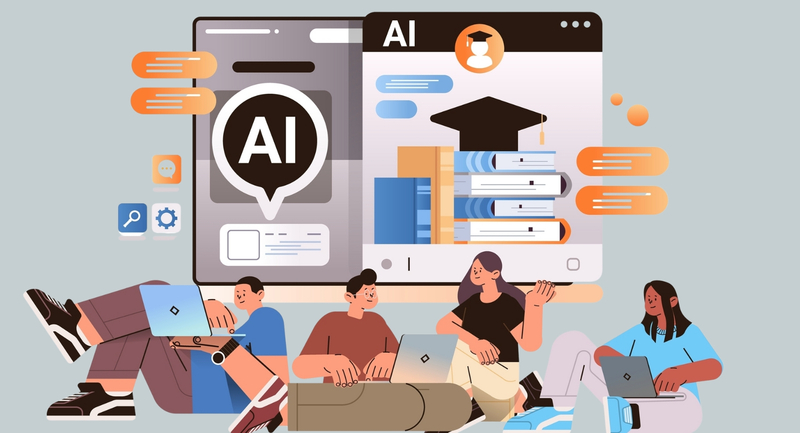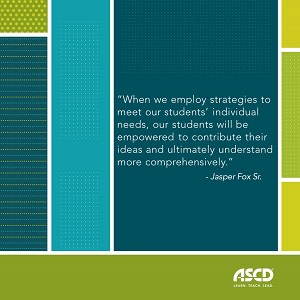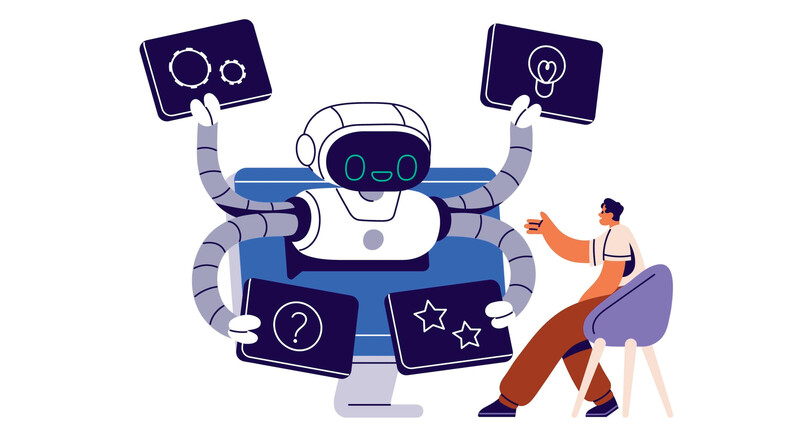The rapid emergence of generative artificial intelligence (AI) has fundamentally transformed how we work, learn, and communicate across virtually every sector of society. This is especially true for teaching and learning. Yet despite AI's profound impact on education, many educator preparation programs that train pre-service teachers have yet to comprehensively integrate AI literacy into—and across—their curriculum.
In many ways, the gap is understandable. GenerativeAI tools have only become mainstream in the past few years, creating a narrow timeline for educational institutions to integrate new AI skilling content into their established programs. At the same time, current teachers are rapidly adopting the new technology. In late 2023, RAND surveyed a nationally representative sample of educators, finding that only about 18 percent of current teachers used AI tools (and an even smaller percentage for instructional innovation). Compare that to February 2025, when approximately 60 percent of current teachers reported using AI. Yet, many teachers are still wary about using AI in schools. In that same survey from late 2023, about 25 percent of teachers said that using AI tools in K-12 education does more harm than good and even today it is fairly common to see headlines that question and debate the role of AI in schools. As AI becomes increasingly part of daily life, the urgency to prepare new educators with AI knowledge and skills has never been greater.
Pre-service teachers will soon be teaching students who will enter a workforce where AI fluency will be absolutely essential. Therefore, it is incredibly important for new teachers to understand how to leverage AI tools to create innovative and transformational lesson plans, personalize and differentiate instruction that meets diverse student needs, and optimize administrative tasks for efficiency. When new teachers feel confident in their AI skills, they are more able to model responsible AI use and prepare students for future careers.
In an effort to align pre-service teaching curriculum with rapidly advancing technology, ISTE+ASCD partnered with Microsoft to launch Transforming Teacher Preparation, a global initiative that equips future educators with essential AI skills. One key component of this initiative is a five-hour online module available in English, Spanish, and Arabic, AI for Tomorrow's Teachers, that helps pre-service teachers develop foundational AI knowledge, learn from hands-on experience using AI tools, and implement strategies for innovative uses of AI that transform teaching and learning. Since launching in January 2025, the module has been completed by more than 600 pre-service teachers and 200 faculty members from more than 60 colleges and universities. By June 2027, ISTE+ASCD and Microsoft aim to upskill more than 15,500 faculty and pre-service teachers through the Transforming Teacher Preparation initiative.
“[These] materials have been essential to helping onboard our faculty...even some of our skeptics came away feeling like they had a better handle on how they could better teach their students," says Dr. Sherrill Sellers, professor and associate dean at Miami University.
Putting AI into Action in Teaching and Learning
Using engaging videos, hands-on activities, and carefully curated content, AI for Tomorrow’s Teachers guides pre-service teachers through five sections:
- AI As We Know It: Helps pre-service teachers understand what is happening when they use AI, why it matters, and how it will impact the lives of future students.
- AI Skills: Focuses on prompt engineering, image generation, identifying bias and misinformation, and strategies that pre-service teachers can use to leverage AI for their own learning.
- Teaching With AI: Explores how AI can assist with planning, creating activities, and designing assessments.
- Responsible AI Use: Helps navigate copyright laws, protect student data, and apply the model code of ethics to AI use.
- Teaching About AI: Introduces strategies for using AI to teach about digital citizenship and critical thinking and centers active, relationship-centered uses of AI in teaching and learning.
Within the course, teachers learn practical ways to incorporate this technology into their teaching without being overwhelmed by it. Here are three examples of ways to use AI in exciting and innovative ways:
Practice 1: Use AI to Personalize Learning
Personalized learning aligns with ISTE+ASCD’s Transformational Learning Principle of “Connect Learning to the Learner.” Educators can use AI to tailor instruction to meet students’ individual needs and interests by implementing differentiation strategies to embrace learner viability, increase engagement, and advance progress toward mastery.
Specifically, educators can use AI to help develop flexible learning environments that allow for different learning modes simultaneously. Teachers can use AI to create differentiated learning experiences that support multiple students as they develop mastery of the same concept.
For example, with skillful prompting, an 8th grade social studies teacher in Indiana could use AI to generate a project-based, cooperative lesson—aligned to Indiana Department of Education Standards—where students use and interpret historical maps of their local area from 1800-1850 to identify natural resource distribution, compare and contrast land use patterns between the early 1800s and today, and create visual presentations showing changes over time as a culminating project to demonstrate mastery.
AI could help that same teacher build a targeted instruction plan to support a single student master that same concept using:
- Scaffolded questioning: What do you see on this map? Can you point to any natural resources like rivers, forests, or mountains?
- Teacher modeling: When I look at an old map, I start by figuring out where I am. Let me show you this major landmark.
- Guided practice: Now you try. Can you find…?
- Personalized feedback and support: What part of reading old maps was hardest for you?
When used effectively, AI can be a powerful tool to help new teachers meet the diverse learning needs of their students.
As AI becomes increasingly part of daily life, the urgency to prepare new educators with AI knowledge and skills has never been greater.
Practice 2: Protect Student Information
While educators can harness the power of AI to transform learning in their classrooms, they are also legally and ethically responsible for protecting student information. Privacy protection needs careful consideration before implementing any AI system in the teaching environment. Family Educational Rights and Privacy Act (FERPA), Individuals with Disabilities Education Act (IDEA), Children’s Online Privacy Protection Act (COPPA), Protection of Pupil Rights Amendment (PPRA), among others, provide legal guidelines governing student data privacy.
To safely bring AI tools into the classroom, teachers should:
- Read privacy policies to look for what data is collected, check how long data is stored, and see if data is shared with third parties
- Use expert resources and validations, including but not limited to:
Pairing the critical eye of a trained teacher with external validations/certifications on AI-powered edtech tools, teachers can safely and effectively integrate AI tools into the classroom.
Practice 3: Foster Digital Citizenship
Tomorrow's teachers will need to prepare students to become active and engaged digital citizens who have the skills to navigate traditional online spaces, but also know how to critically evaluate AI-generated content, understand the implications of AI bias, and make ethical decisions about when and how to use AI tools. The ISTE Standards for Students identify four aspects of being a digital citizen: Digital Footprint, Online Interaction, Safeguard Well-being, and Digital Privacy.
AI itself can become a powerful ally in creating transformational digital citizenship learning experiences. Teachers can use AI tools to:
- Generate realistic scenarios for ethical discussions
- Create personalized case studies that resonate with individual students' experiences
- Develop interactive simulations that allow students to explore the consequences of different digital choices in safe environments
- Craft age-appropriate content about complex topics like data privacy, algorithmic bias, and digital footprints
By using AI to teach digital citizenship, educators can model responsible AI use while giving students hands-on experience evaluating AI-generated materials—turning the technology itself into both the subject and the tool for developing critical digital literacy skills.
Preparing for the Future
AI will continue to change the landscape of education. ISTE+ASCD and Microsoft are committed to helping future teachers harness the power of AI to make teaching and learning amazing, accessible, and effective for all students.
As one pre-service teacher who took the AI for Tomorrow’s Teachers module summed it up, “Getting to look at and interact with AI, I see that it doesn't have to be a scary thing.”
To learn more about ISTE+ASCD’s teacher preparation initiatives, visit the Teacher Preparation web site and watch this short video.
Author's Note: This blog post was created in collaboration with Microsoft.








